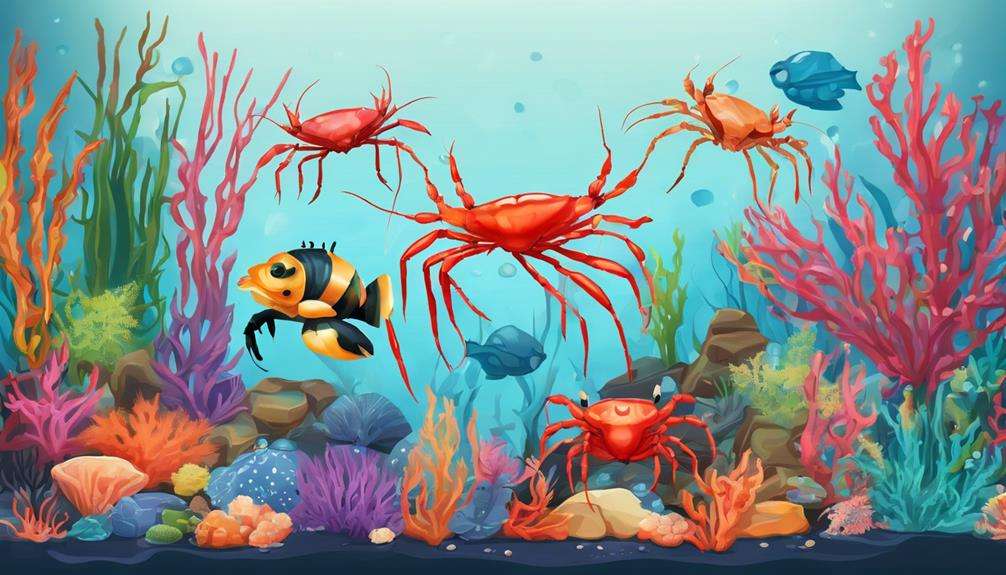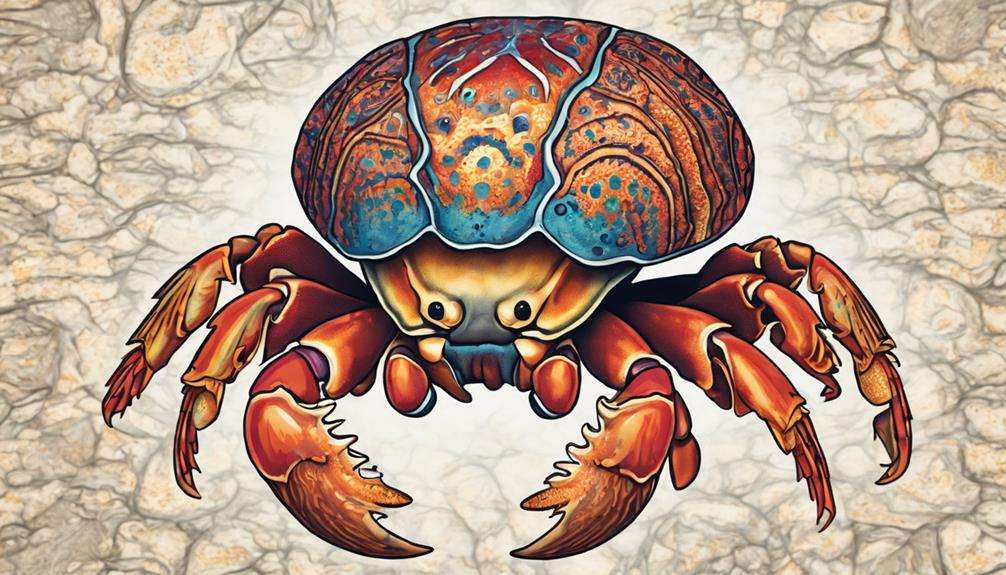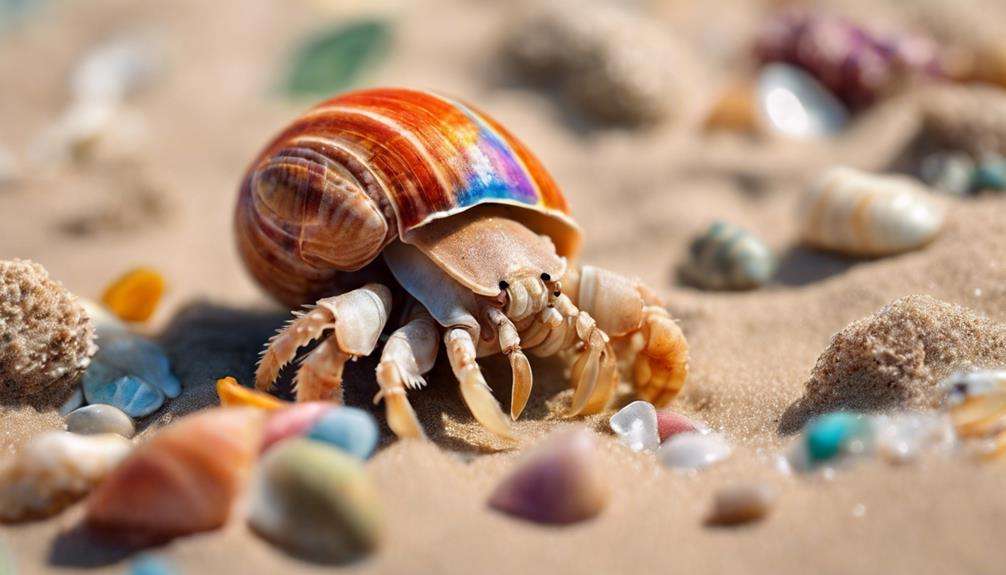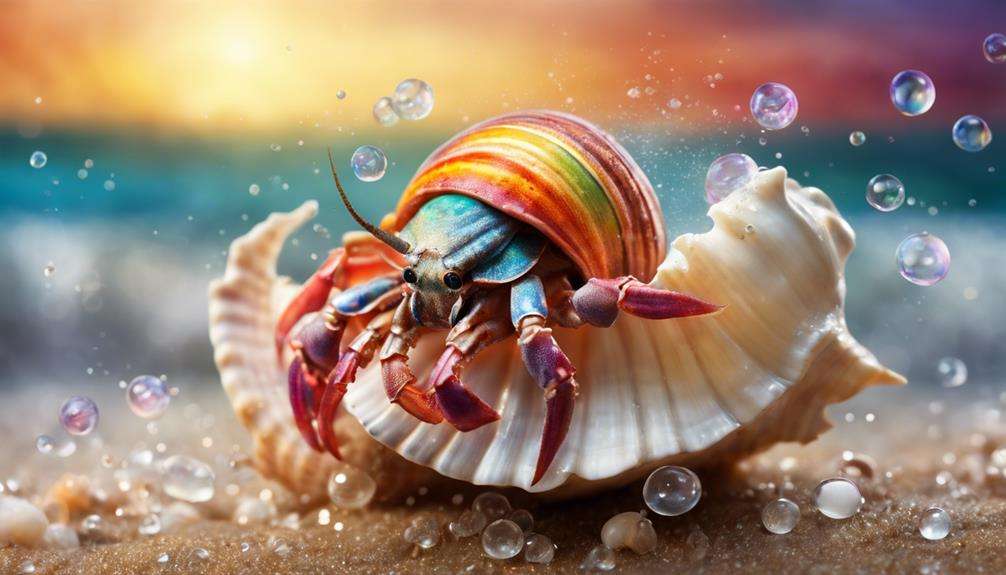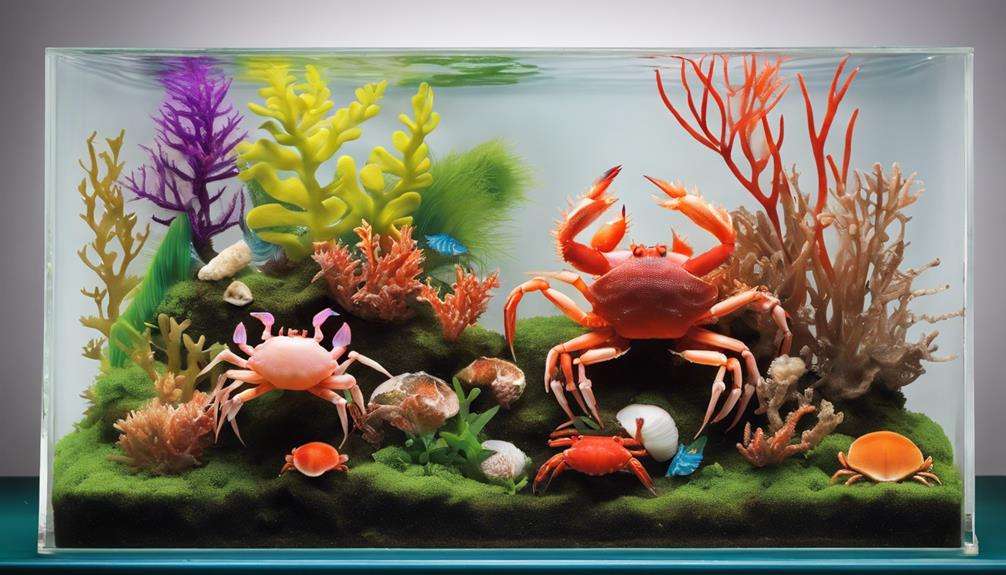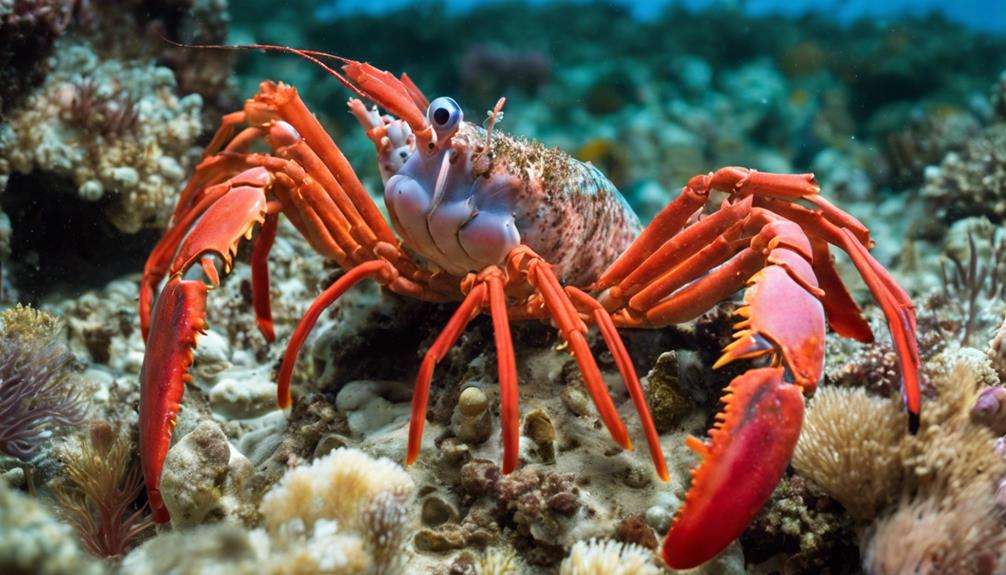Ever wondered about the secret behind the captivating hues of certain crustaceans?
It's not just a matter of chance; there's a fascinating interplay between biological components that gives rise to these vibrant colors.
As you contemplate the intricate mechanisms at play, you'll uncover a world where genetics, environment, and evolutionary pressures converge to create a visual spectacle that serves a deeper purpose beyond mere aesthetics.
Stay tuned to unravel the mysteries behind the kaleidoscopic shells of these fascinating creatures.
Key Takeaways
- Crustaceans evolved vibrant colors for protective camouflage and communication.
- Genetic mechanisms, like crustacyanin genes, contribute to stunning hues.
- Astaxanthin pigment interacts with crustacyanin for brilliant shell colors.
- Environmental cues and genetic duplication events lead to diverse and vibrant color patterns.
Evolutionary Adaptations for Vibrant Colors
Crustaceans have evolved intricate genetic mechanisms to develop vibrant colors as a means of protective camouflage and communication within their diverse habitats. The evolutionary adaptations responsible for the stunning hues seen in crustaceans involve the interplay of crustacyanin genes and astaxanthin, a carotenoid pigment. Specific crustacyanin genes underwent duplication in early crustacean ancestors, contributing to the diversity of vibrant shell colors observed today. This genetic duplication allowed for a wider range of color expression, enhancing their ability to blend into their surroundings and communicate effectively with conspecifics.
The vibrant shell colors seen in crustaceans aren't merely for aesthetic purposes but play a crucial role in their evolutionary success. These colors aid in protective camouflage, allowing crustaceans to evade predators and ambush their prey effectively. Additionally, vibrant colors facilitate communication within their ecosystems, enabling individuals to signal their readiness to mate, establish social hierarchies, or warn others of potential dangers. Understanding the genetic mechanisms behind crustacean color production provides valuable insights into their evolutionary strategies and the remarkable diversity of color patterns observed in these fascinating creatures.
Role of Pigments in Crustaceans
Pigments present in the exoskeleton of crustaceans, such as astaxanthin, interact with proteins like crustacyanin to produce a diverse array of vibrant shell colors. Astaxanthin, when bound to crustacyanin, undergoes a twist that alters its wavelength, resulting in the brilliant shell colors seen in crustaceans. Specific expression of crustacyanin genes in the tissue beneath the exoskeleton controls the intricate shell color patterns observed in these creatures. Cooking disrupts the protein complex, releasing the red astaxanthin pigment and changing the shell color to red.
Astaxanthin, when bound to crustacyanin, undergoes a twist that alters its wavelength, leading to diverse shell colors.
Specific expression of crustacyanin genes in the tissue beneath the exoskeleton controls the intricate shell color patterns.
Cooking disrupts the protein complex, releasing the red astaxanthin pigment and changing the shell color to red.
Environmental Influences on Coloration
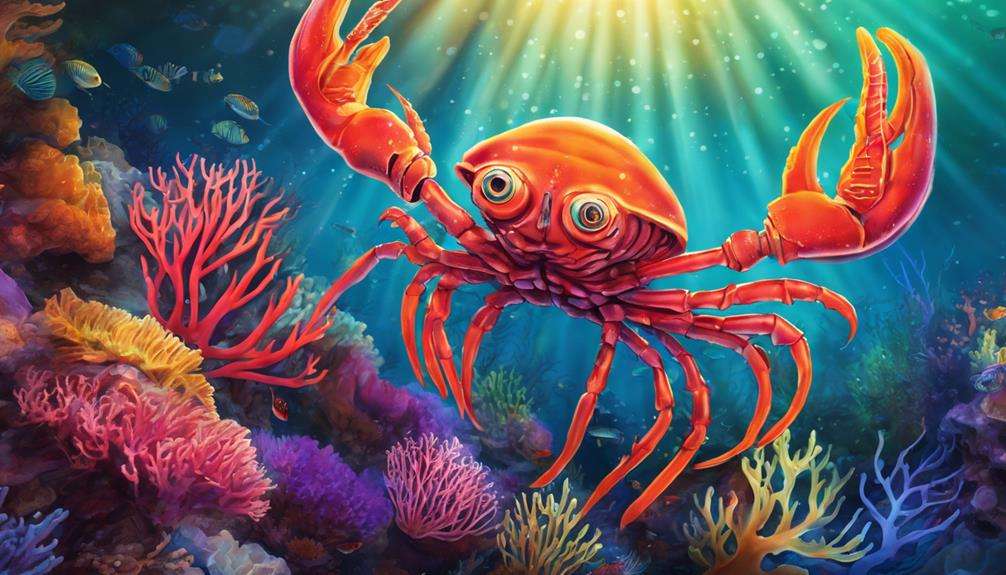
Environmental influences play a crucial role in determining the vibrant colors of crustaceans. Factors such as adaptation to habitats, camouflage strategies, and mating rituals all contribute to the coloration of these fascinating creatures.
Understanding how environmental cues shape crustacean color patterns provides valuable insights into their survival strategies and evolutionary processes.
Adaptation to Habitats
Adapting to their surroundings, crustaceans showcase a remarkable range of vibrant colors that play a crucial role in their survival strategies against predators and in mate selection within their diverse habitats. Environmental influences such as water depth, substrate color, and light availability shape the coloration of crustaceans.
The ability to adjust shell colors enables these creatures to blend seamlessly into their environments, providing protective camouflage. Crustaceans in different habitats may exhibit specific color patterns to match the environmental conditions they inhabit accurately.
Vibrant colors serve as a mode of communication and a visual cue for mate selection, ultimately enhancing their reproductive success. These adaptations highlight the intricate relationship between coloration, habitat, and survival strategies in the fascinating world of crustaceans.
Camouflage Strategies
In response to their surroundings, crustaceans intricately adjust their vibrant colors as a crucial camouflage strategy to seamlessly blend into diverse environments, ensuring their protection from predators. Environmental factors play a significant role in shaping the shell colors of crustaceans, with genetic mechanisms controlling the color intensity to match the background effectively.
Vibrant shell colors aid in concealing crustaceans among rocks, corals, or algae, enhancing their survival by minimizing their visibility to predators. The intricate color patterns serve as a defense mechanism, allowing these creatures to hide and thrive in various habitats.
Through background matching, crustaceans adapt their coloration to the specific environment they inhabit, showcasing the evolutionary significance of camouflage strategies in their survival and reproductive success.
Mating Rituals Influence
Influenced by their mating rituals, crustaceans develop vibrant colors, with males often showcasing brighter hues to attract females.
Environmental factors such as light availability and habitat complexity can impact the intensity and patterns of coloration during courtship displays.
Color variations in crustaceans play a crucial role in mate selection, as females tend to prefer brightly colored males as a signal of genetic fitness.
Some species exhibit color changes during courtship, where males enhance their vibrant colors to indicate readiness to mate and establish dominance.
Vibrant coloration serves as a visual cue during courtship displays, aiding in species recognition and facilitating successful mating interactions.
Genetics Behind Crustacean Coloration
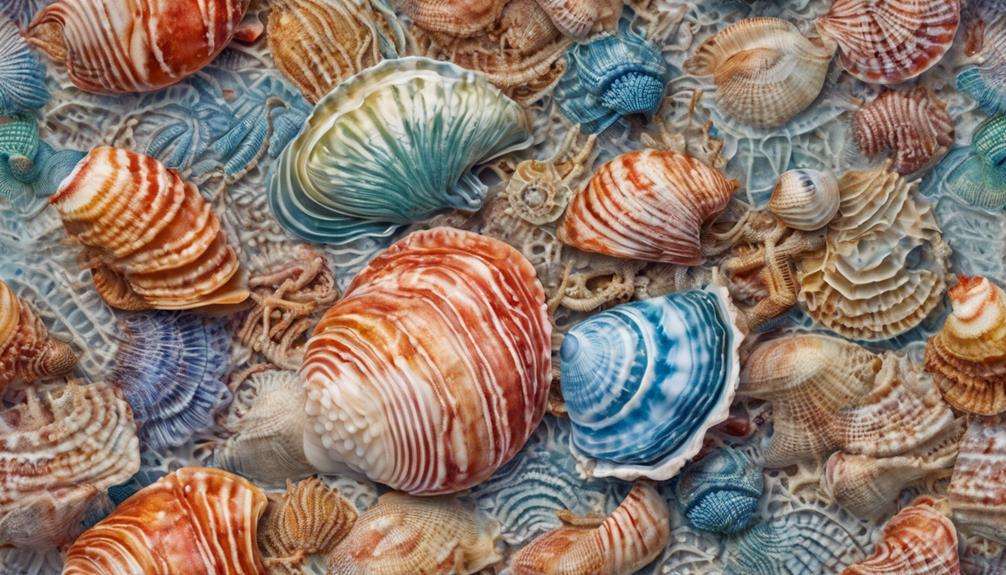
Crustaceans display a diverse array of colors dictated by the intricate genetic regulation of crustacyanin genes. This genetic control is further influenced by environmental factors, shaping the vibrant hues seen in these fascinating creatures.
Understanding the interplay between genetic mechanisms and environmental cues is crucial in unraveling the captivating color palette of crustaceans.
Color Genes in Crustaceans
With a complex interplay of specific color genes like crustacyanin and carotenoids, crustaceans showcase a stunning array of vibrant shell colors that are intricately controlled at the genetic level.
The genetic mechanisms behind crustacean color production involve the expression of crustacyanin genes in the tissue beneath the exoskeleton, influencing the intricate shell coloration and patterns.
Evolutionary genetics play a crucial role in the duplication and evolution of crustacyanin genes, contributing to the diverse color patterns observed in crustaceans.
Understanding these color genes not only enhances our knowledge of genetic diversity within crustacean populations but also aids in conservation efforts to protect these fascinating creatures.
Environmental Factors Influence
Environmental factors intricately interact with genetic mechanisms to influence the vibrant coloration seen in crustaceans' shells. Genetic factors, such as the expression of the crustacyanin gene and efficient absorption of carotenoids, determine the specific hues and patterns displayed by crustaceans.
These genetic mechanisms not only impact crustacean color intensity but also play a crucial role in optimizing coloration for aquaculture efficiency. Understanding the genetic basis of crustacean color production can lead to enhanced color consistency and intensity in these aquatic species.
Unique Color Patterns in Crustaceans
Exhibiting a mesmerizing array of hues, crustaceans display intricate and distinctive color patterns that stem from the complex interplay of crustacyanin and astaxanthin within their shells. These unique color patterns are a result of the protein crustacyanin binding with the carotenoid astaxanthin, allowing for a diverse range of shell colors in crustaceans.
Moreover, the specific expression of crustacyanin genes beneath the exoskeleton plays a crucial role in controlling the intricate color patterns seen in various crustacean species. Evolutionary genetics studies have shown that crustaceans have evolved to utilize a carotenoid-protein complex for coloration, with crustacyanin genes evolving through duplication in early crustacean ancestors.
Understanding the genetic mechanisms behind crustacean color production not only contributes to the scientific field but also aids in conservation efforts, enhances aquaculture practices, and supports the development of new food colorants.
Factors Affecting Color Diversity
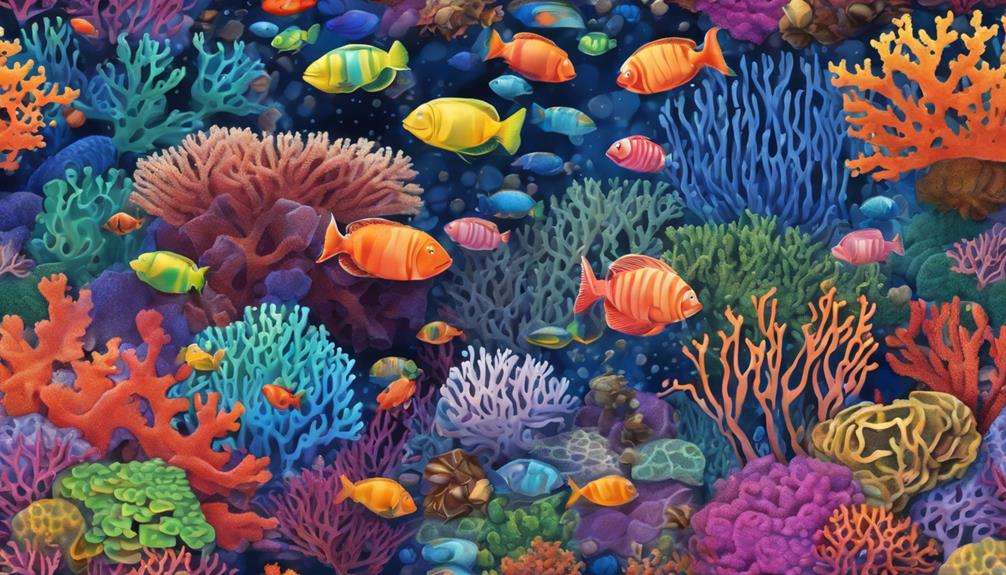
Color diversity in crustaceans is intricately influenced by the interplay between the protein crustacyanin and the carotenoid astaxanthin. When astaxanthin binds to crustacyanin, it undergoes a unique twist, allowing for a wide array of vibrant shell colors to be expressed.
Genetic duplication events of specific crustacyanin genes in early crustacean ancestors have played a crucial role in the development of the diverse color patterns observed in crustaceans today. The expression of these crustacyanin genes in the tissue beneath the exoskeleton serves as a key mechanism controlling the intricate and vibrant shell coloration in these organisms.
Understanding the genetic mechanisms behind crustacean color production not only sheds light on their color diversity but also opens up avenues for the creation of novel food colorants and additives. The intricate interplay of protein crustacyanin and carotenoid astaxanthin within crustaceans showcases the complexity and beauty of their shell colors, making them a fascinating subject of study in the realm of biology and genetics.
Significance of Bright Colors in Crustaceans
The intricate genetic mechanisms underlying the vibrant shell colors of crustaceans not only contribute to their camouflage and mate selection but also reveal fascinating insights into their evolutionary adaptations and ecological roles in marine environments.
Crustaceans utilize their shell colors for protective camouflage against predators in their diverse habitats, enhancing their chances of survival. These colors also play a crucial role in mate selection and communication within their species, allowing for effective interactions and reproduction. Furthermore, the genetic determination of these vibrant colors ensures consistency across molts, aiding in individual recognition and ultimately contributing to species survival.
Rare Color Variations in Crustaceans
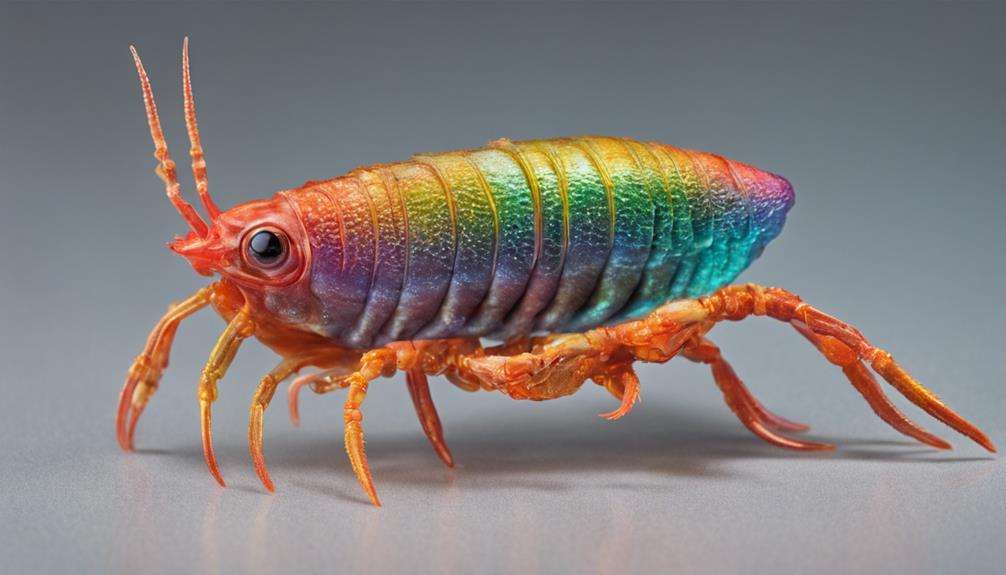
Rare deviations in crustaceans' shell colors, stemming from genetic anomalies, present intriguing variations that add to the allure of these marine creatures.
Albino lobsters, a striking example of rare color variations, occur at a staggering rate of approximately 1 in 100 million. These unique individuals lack pigments in their shells, resulting in a distinct gray-white appearance that remains even after cooking.
Genetic mutations affecting pigment production can lead to atypical and visually captivating shell colors in crustaceans. Some individuals display vibrant blues, purples, and even fluorescent hues, showcasing the genetic diversity within crustacean populations.
These rare color variations serve as a testament to the fascinating genetic diversity present in crustaceans, highlighting the potential for the emergence of uniquely colored individuals.
The occasional appearance of these unique colored crustaceans adds a layer of intrigue to the already diverse array of vibrant shell colors found in these captivating marine creatures.
Conservation of Colorful Crustaceans
Understanding the intricate genetic diversity underlying the vibrant colors of crustaceans is crucial for effective conservation efforts. Genetic studies on colorful crustaceans not only aid in preserving their unique traits but also enhance their survival in changing environments.
Conservation initiatives focus on protecting the habitats of these colorful crustaceans to ensure their continued presence in ecosystems. Highly colored crustaceans play a significant role in attracting attention and raising awareness for conservation purposes.
The economic value of these vibrant crustaceans serves as a motivating factor for implementing conservation strategies that aim to maintain their populations and habitats. By prioritizing the preservation of these colorful species, conservationists contribute to the overall biodiversity and ecological balance of marine and freshwater environments.
Awareness of the importance of colorful crustaceans in ecosystems drives efforts to safeguard their existence and promote sustainable practices for their conservation.
Frequently Asked Questions
Why Are Most Crustaceans Red?
Most crustaceans appear red when cooked due to astaxanthin pigment release from protein binding. This adaptation aids in camouflage, predation avoidance, and mating displays. Environmental factors influence coloration, offering evolutionary advantages for survival.
How Do Crustaceans Change Color?
When crustaceans change color, various factors like molting, genetics, and diet influence their vibrant hues. Environmental cues, UV light, and communication signals also play roles in their color adaptations for camouflage, mating rituals, and predator avoidance.
Why Do Crustaceans Appear Pink When They Are Cooked?
When crustaceans are cooked, the color transformation occurs due to the breakdown of proteins that bind to astaxanthin pigment. Heat influences molecular changes, denaturing proteins, and revealing the red pigment, enhancing culinary aesthetics through chemical reactions.
What Are Three Characteristics That Are Unique to Crustaceans?
Crustaceans possess a protective exoskeleton crucial for survival, undergo molting for growth, and have complex compound eyes for hunting. Their carnivorous diet, unique appendages, and social behavior enhance their adaptability and ecological role.
Conclusion
In conclusion, crustaceans' vibrant colors are a result of a fascinating interplay between crustacyanin and astaxanthin, shaped by evolutionary genetics. These intricate color patterns serve as adaptive camouflage, communication tools, and even economic assets in the seafood market.
Understanding the genetic, environmental, and evolutionary factors behind crustacean coloration sheds light on the beauty and complexity of these remarkable creatures.

